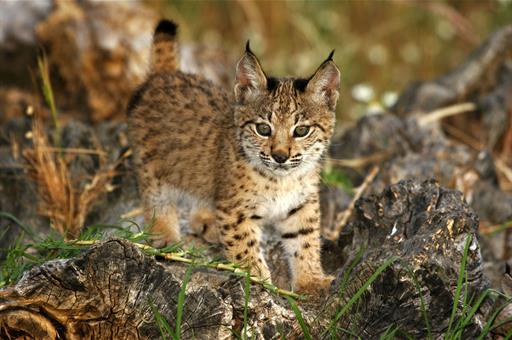After exceeding 1,000 specimens in 2020, the Iberian population has doubled in just three years.
The census work on the Iberian lynx (Lynx pardinus) in Spain and Portugal carried out in 2023 has shown that the species has surpassed the 2,000 mark, which is a new maximum number since detailed monitoring of its populations has been carried out. This is reflected in the report drawn up by the Iberian lynx working group, which is coordinated by the Ministry for Ecological Transition and the Demographic Challenge and made up of representatives of the Spanish autonomous communities and the Portuguese Institute for Nature and Forest Conservation.
TDB keeps you informed. Follow us on Facebook, Twitter and Instagram
The Iberian lynx population surpassed 2,000 in 2023
The document shows that a total of 2,021 lynx have been counted, distributed between Spain (1,730, or 85.6%) and Portugal (291). There are four Spanish autonomous communities with stable populations of the species. Andalusia was home to 755 lynxes, accounting for 43.6 % of the Spanish population, while Castilla-La Mancha recorded 715 lynxes (41.3 %). In Extremadura, 253 specimens were recorded and in the Region of Murcia 7.
Of the total number counted, 1,299 lynx were adults or sub-adults with a sex ratio of 1.01 in favour of females (602 males and 611 females that could be sexed). The number of breeding or territorial females in 2023 was 406, which is 80 more than in 2022, and which is gradually approaching the 750 breeding females which is preliminarily considered as one of the demographic objectives to be reached to consider the lynx to be in a favourable conservation status. The number of cubs born in 2023 also increased to 722, with a fecundity rate of 1.77 calculated as the number of cubs born divided by the number of territorial females.
The lynx population continues to expand, both numerically and territorially. There are now 14 different geographical areas where the species breeds and new areas of stable presence in the Region of Murcia and in the provinces of Albacete, Badajoz, Toledo and Ciudad Real. The population trend has been positive and continuous since 2015, which allows us to remain optimistic about the reduction of the risk of extinction of the Iberian lynx. In a period of around 20 years, the population has gone from less than 100 specimens counted in 2022 to more than 2,000 in 2023. And in recent years the increase is even more remarkable, since in 2020 the total population was 1,111 lynx and three years later almost 900 more individuals have been added to the Iberian population.
The technical report produced by the Iberian lynx working group in Spain and Portugal made up of the competent environmental administrations, can be consulted on the website of the Ministry for Ecological Transition and the Demographic Challenge.
A coordinated programme that has yielded good results
The recovery of the Iberian lynx population in Spain and Portugal is one of the best examples of conservation actions for endangered species in the world and has been possible thanks to the coordinated efforts of both the competent public administrations and interested sectoral bodies, owners and managers of private estates and society in general. The financial contribution of the Spanish and Portuguese administrations and of the European Union, through the LIFE programme, has been key to the execution of the monitoring and research work and to the improvement of survival, reproduction and habitat improvement rates.
The ex-situ conservation programme, which includes captive breeding and the reintroduction of specimens, has also been a key element in the recovery of the lynx. It has been carried out under fruitful cooperation and coordination between the Portuguese and Spanish authorities, articulated in the framework of the Memorandum of Understanding for the development of a single coordinated programme of actions for the application of the Iberian Lynx Conservation Strategy in Spain. Breeding in captivity is a very important economic effort for the administrations that have been covering this cost with their own means, which are the ICNF of Portugal in the Silves breeding centre, the Junta de Andalucía in the centre of La Olivilla (Jaén) and the Autonomous National Parks Body of the Ministry for Ecological Transition and the Demographic Challenge in the centres of Zarza de Granadilla (Cáceres) and El Acebuche (Huelva).
Since the first releases of captive-born individuals into the wild began in 2011, 372 individuals have been reintroduced by 2023. The reintroduction areas initially selected for the release of lynx, which were Vale do Guadiana in Portugal, Guarrizas and Guadalmellato in Andalusia, Montes de Toledo and Sierra Morena Oriental in Castilla-La Mancha, and Matachel in Extremadura, have recently been joined by new reintroduction areas approved by the Iberian Lynx Working Group, as it has been confirmed that the ecological and social requirements for reintroduction have been met. Thus, the core areas of Sierra Arana in Andalusia, Valdecañas-Ibores and Ortiga in Extremadura, Tierras Altas de Lorca in the Region of Murcia and Campos de Hellín in Castilla-La Mancha already have released and settled Iberian lynx specimens. Other connecting areas also host lynx on a stable basis, either through releases of captive-born individuals or through natural settlement of wild individuals, in the provinces of Seville, Toledo or in the Cabañeros National Park.
It is expected that the number of areas selected for reintroduction will increase in the coming months and years, due to the interest of several autonomous communities in evaluating the suitability of lynx recovery in their territories.
